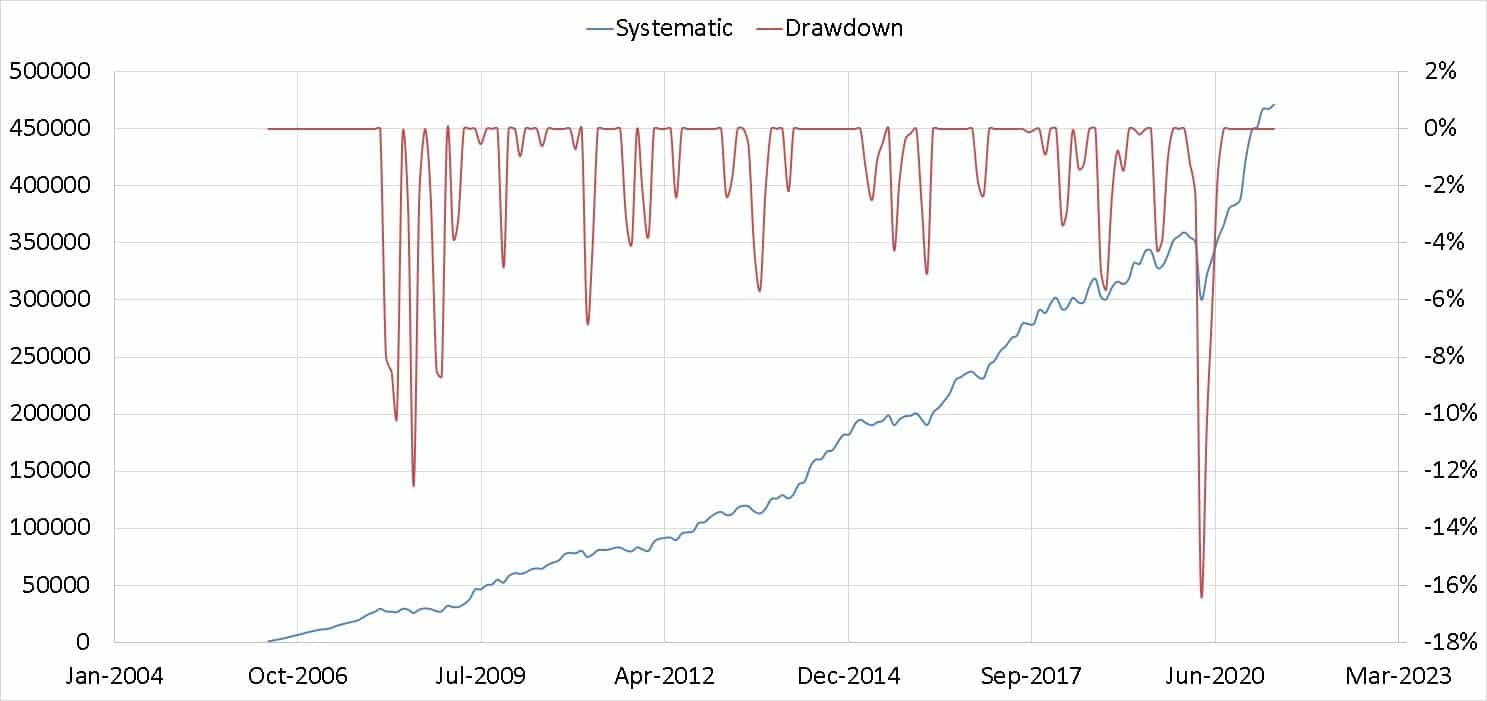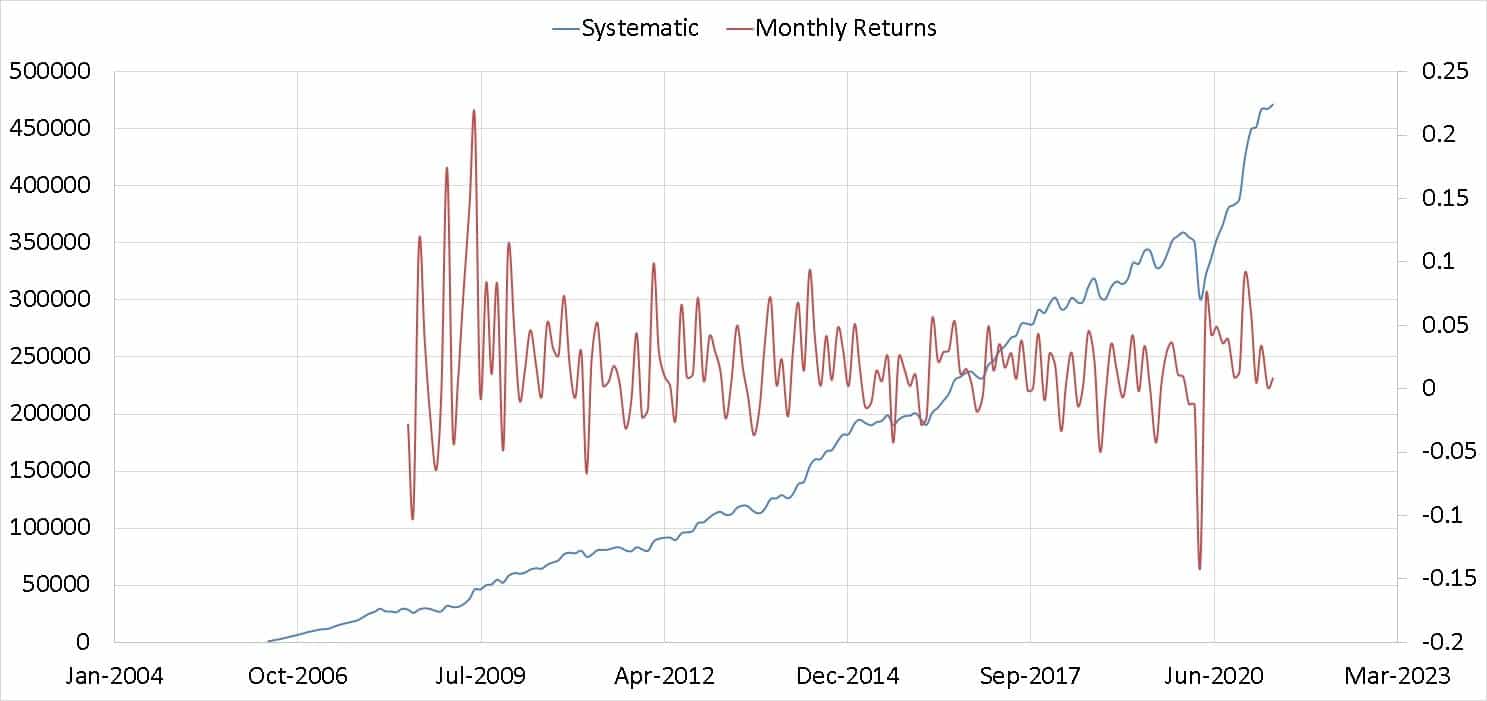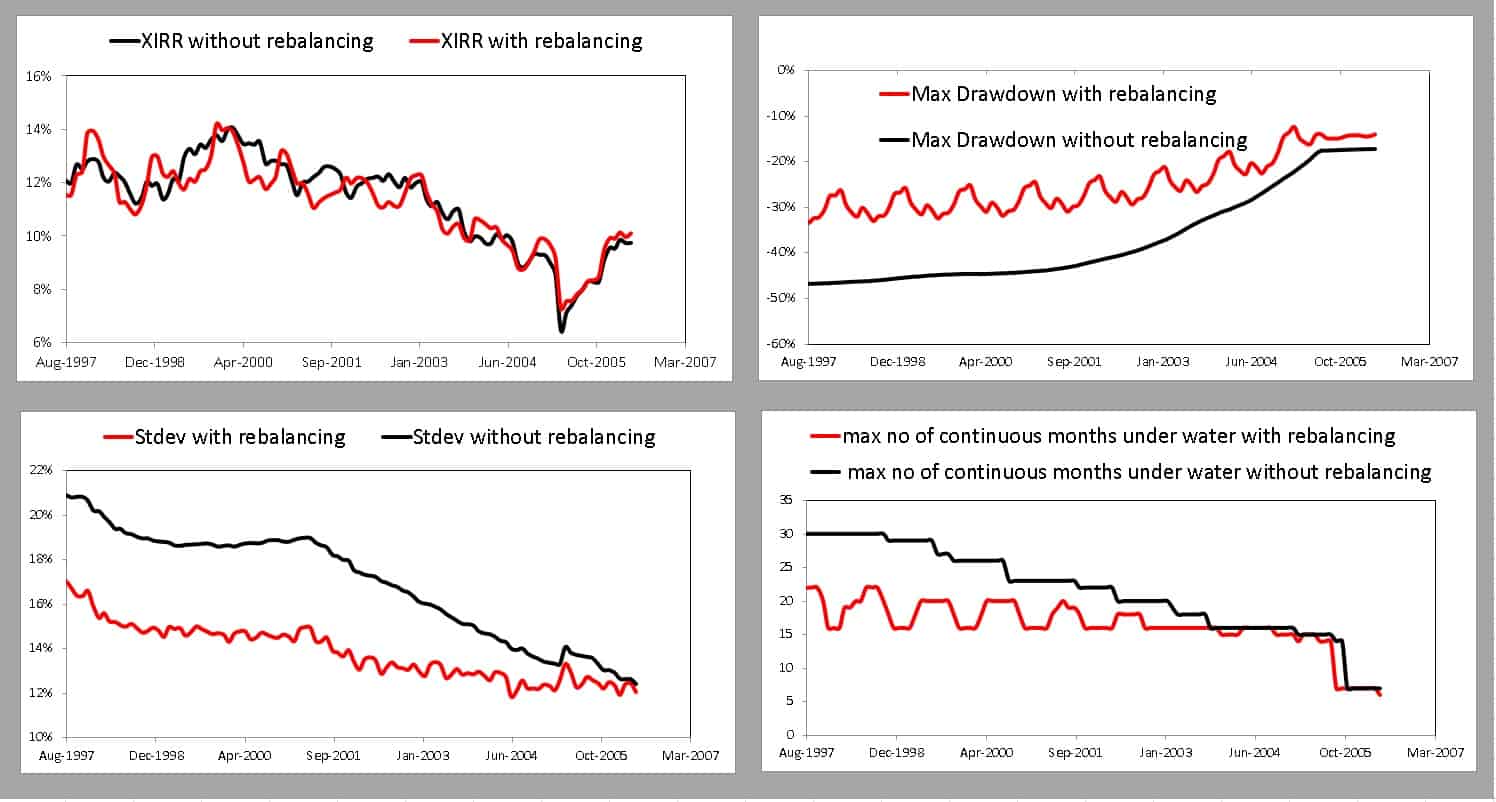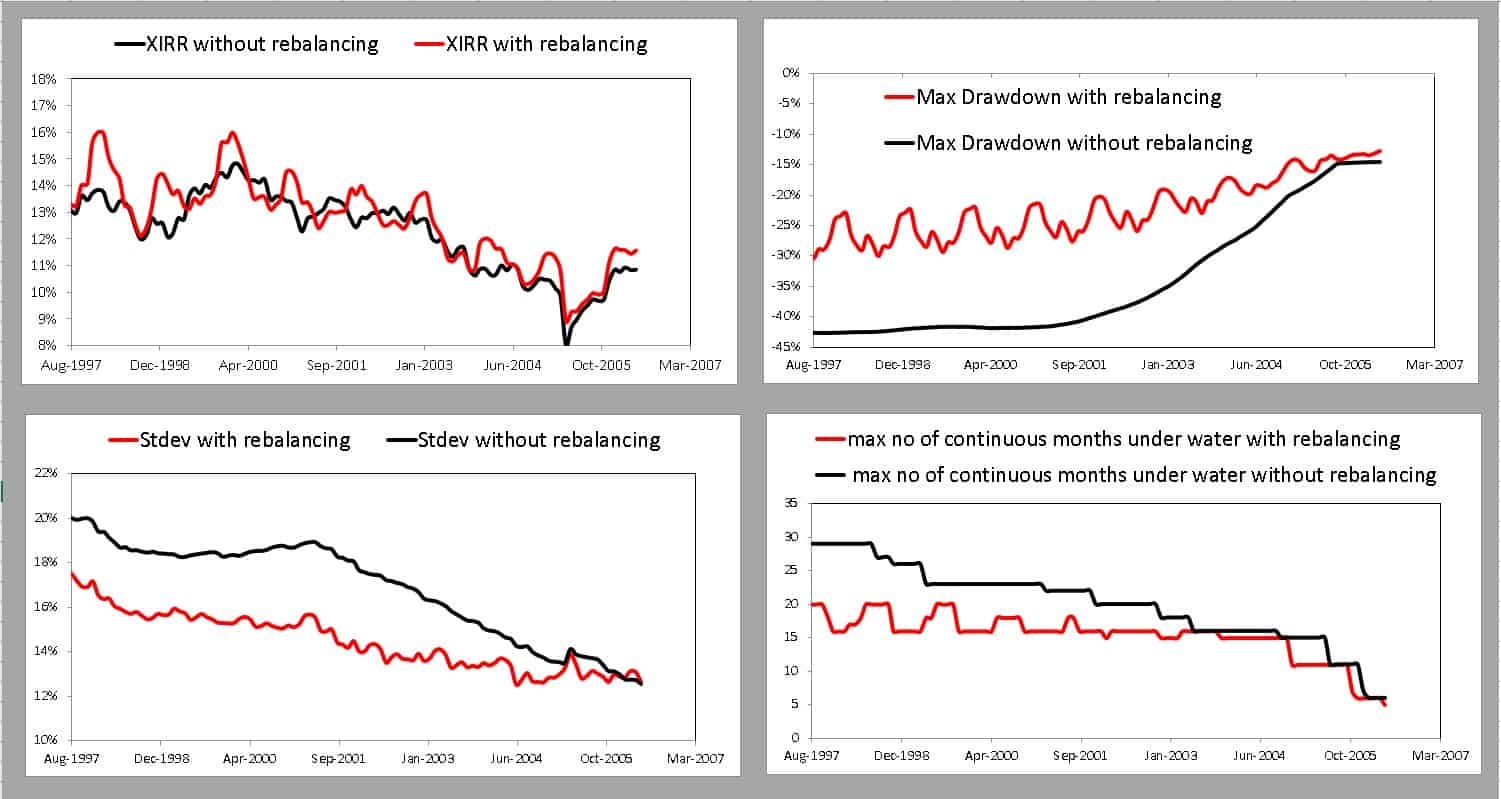Last Updated on December 29, 2021 at 6:14 pm
In this article, we discuss the benefits of portfolio rebalancing. Many investors find the topic difficult to understand and implement. So let us begin with a discussion of the basics. When we create a projection on Excel, we assume a 10% or 12% return from equity.
On a spreadsheet, our money grows each year by that assumed return. However, real-life is quite different. One year you could get 90% from equity resulting in this: My net worth doubled in the last financial year thanks to patient investing! Another year, you get a 30-40% loss resulting in this: My retirement equity MF portfolio return is 2.75% after 12 years!
It is a matter of simple commonsense to safeguard some of those profits. There are benefits to investing more when the market is down. This is what rebalancing tries to accomplish. From another perspective, it can seem counterintuitive: you need to remove some money from the stock market during a bull run (when the going is good) and invest some money during a bear run (when the market is down).
Why do this? How often do you get the kind of returns we saw from March 2020 to March 2021 (about 90% ish)? More is most likely to happen in the next year? A huge gain is either followed by a subdued gain or a loss. Rebalancing reduces the up and down swings in our portfolio, takes us close to our target corpus and gives us a psychological boost.
Join 32,000+ readers and get free money management solutions delivered to your inbox! Subscribe to get posts via email! (Link takes you to our email sign-up form)
🔥Want to create a complete financial plan? Learn goal-based investing? Exclusive access to our DIY tools? Increase your income with your skills? Enjoy massive discounts on our robo-advisory tool & courses! 🔥
What do you need to rebalance a portfolio? (1) A solid financial plan. (2) A simple, minimalistic portfolio with two or three asset classes (stocks, bonds/debt, gold). A desire to reduce risk in real-time and not leave the fate of our investments to luck.
All investors have a portfolio, but only a few of them make informed decisions while assembling it. Most people suffer from shiny object syndrome and buy every new product in town. Rebalancing is a tertiary problem for them.
If you are interested in rebalancing, you need an asset allocation: how much am I currently investing in equity and debt. How much should I be investing in equity for my goal? How do I get there? How long will it take? After I get there, how am I going to vary my asset allocation?
For example. I have 20% equity and 80% debt. I need at least 40-50% equity for my goal. I need 3-4 years to increase equity allocation from 20% to 40%. After I get there, I will rebalance my portfolio each year to maintain the asset allocation at 40% equity and 60% debt. I will reduce the equity holding by a few percentage points every few years to ensure risk is reduced as the goal deadline is reduced. Absolute beginners can start with this seminar: Basics of portfolio construction: A guide for beginners.
Suppose you have hit that target asset allocation of 40% equity and 60% debt; because of market fluctuations, it will not stay there. Every day it will fluctuate, and at least once a year, a reset is necessary. Suppose the equity allocation has become 45% and the debt allocation 55%, you need to withdraw 5% from your debt holdings and invest into equity or vice versa. Why do this? What is the benefit? This shall be our focus here.
Many people assume they can save on taxes and no rebalance the portfolio. They would change the amounts they invest in equity and debt each month to ensure the asset allocation does not deviate much. The problem is, most investors cannot imagine themselves as ever getting rich. The networth doubling stories happen to someone else, not them.
This kind of “rebalancing” adjusting monthly investments can only last until the portfolio value is comparable to the monthly investment. When I rebalanced my retirement portfolio after 13Y a few weeks ago, the amount I shifted from equity to debt was equal to the value of my equity holdings in 2012 and more than what I currently invest annually. You cannot “adjust” this by changing investment amounts. If you are currently doing this, I hope you get rich real fast!
A comprehensive three-part FAQ on portfolio rebalancing is available. After persuing the results below, I recommend readers unfamiliar with rebalancing to go through these.
- Portfolio Rebalancing: We answer frequent questions investors worry about (part 1)
- Portfolio Rebalancing FAQ Part 2
- Portfolio Rebalancing FAQ Part 3
To understand the benefits of rebalancing, we shall consider a systematic monthly investment over 15 years into an asset allocation of 50% and the rest in debt. The NSE 500 TRI will represent “equity”. For debt, we shall consider two cases: the I-BEX gilt index and a simple fixed-income instrument with an annual return of 6%. The portfolio will be rebalanced once every 12 months. We will consider 137 15-year periods from Jan 1995 to May 2021. We do not factor taxes or exit loads as they have changed so many times in the past.
50% equity and 50% fixed income
First, let us consider the results with 50% equity and 50% fixed income.
- Top left: The XIRR (annualized return) for the 137 runs are shown
- Top right: The max fall from an all-time high (of the portfolio value)
For example, shown below is one of the 137 runs (the most recent one). The fall from the peak is shown on the right (drawdown). The max drawdown (or the longest stalactite) is selected from this.

- Bottom left: The standard deviation of the monthly change in portfolio value. The monthly returns for one of the runs are shown below.

- Bottom right: The no of continuous months the portfolio was below its previous maximum. This corresponds to the widest drawdown stalactite.
The results are compiled below. We recommend that readers inspect the graph for a bit to appreciate the results. The red line refers to a portfolio with annual rebalancing and the black line without rebalancing.

- Top left: Rebalancing between equity and fixed income sometimes results in more returns and sometimes not.
- Top right: Rebalancing significantly reduces loss from a maximum.
- Bottom left: Rebalancing significantly reduces fluctuations in portfolio value.
- Bottom right” Rebalancing typically reduces the duration the portfolio was continuously underwater. That is below the previous maximum.
50% equity and 50% gilts
Now, if we replace the fixed income component with gilts, we have two volatile asset classes. When one of them does well, there is a chance the other does not and vice versa. This makes it perfect for rebalancing. We sell high in one asset class and buy low in another. See: If equity MF returns are negative, will gilt MF returns be positive?

- Top left: Rebalancing between equity and gilts typically results in better returns than between equity and fixed income. Considering tax, the equity-gilt combo is a better choice, but strictly for 10+ years goals for the typical investor.
- Top right: Rebalancing significantly reduces loss from a maximum.
- Bottom left: Rebalancing significantly reduces fluctuations in portfolio value.
- Bottom right” Rebalancing typically reduces the duration the portfolio was continuously underwater. That is below the previous maximum.
In summary, for those who appreciate risk reduction or lower portfolio volatility, rebalancing provides significant benefits regardless of the returns or tax. They provide a real and psychological boost of “safeguarding gains”. As you start driving from point A to B, rebalancing is like a friendly GPS offering you traffic advice, such as “high traffic up ahead, take a detour”. It helps you stay the course.
However, only those who appreciate risk reduction in real-time would appreciate rebalancing. Those addicted to hindsight bias would say, “I just need to get to point B, does not matter how”. This is like saying, “I have started a SIP in a five-star fund”. Sadly there are no guarantees of getting to point B. Rebalancing with a plan increases the odds in our favour.
🔥Enjoy massive discounts on our courses, robo-advisory tool and exclusive investor circle! 🔥& join our community of 7000+ users!
Use our Robo-advisory Tool for a start-to-finish financial plan! ⇐ More than 2,500 investors and advisors use this!
Track your mutual funds and stock investments with this Google Sheet!
We also publish monthly equity mutual funds, debt and hybrid mutual funds, index funds and ETF screeners and momentum, low-volatility stock screeners.





- Do you have a comment about the above article? Reach out to us on Twitter: @freefincal or @pattufreefincal
- Have a question? Subscribe to our newsletter using the form below.
- Hit 'reply' to any email from us! We do not offer personalized investment advice. We can write a detailed article without mentioning your name if you have a generic question.
Join 32,000+ readers and get free money management solutions delivered to your inbox! Subscribe to get posts via email! (Link takes you to our email sign-up form)
About The Author
 Dr M. Pattabiraman(PhD) is the founder, managing editor and primary author of freefincal. He is an associate professor at the Indian Institute of Technology, Madras. He has over ten years of experience publishing news analysis, research and financial product development. Connect with him via Twitter(X), Linkedin, or YouTube. Pattabiraman has co-authored three print books: (1) You can be rich too with goal-based investing (CNBC TV18) for DIY investors. (2) Gamechanger for young earners. (3) Chinchu Gets a Superpower! for kids. He has also written seven other free e-books on various money management topics. He is a patron and co-founder of “Fee-only India,” an organisation promoting unbiased, commission-free investment advice.
Dr M. Pattabiraman(PhD) is the founder, managing editor and primary author of freefincal. He is an associate professor at the Indian Institute of Technology, Madras. He has over ten years of experience publishing news analysis, research and financial product development. Connect with him via Twitter(X), Linkedin, or YouTube. Pattabiraman has co-authored three print books: (1) You can be rich too with goal-based investing (CNBC TV18) for DIY investors. (2) Gamechanger for young earners. (3) Chinchu Gets a Superpower! for kids. He has also written seven other free e-books on various money management topics. He is a patron and co-founder of “Fee-only India,” an organisation promoting unbiased, commission-free investment advice.Our flagship course! Learn to manage your portfolio like a pro to achieve your goals regardless of market conditions! ⇐ More than 3,000 investors and advisors are part of our exclusive community! Get clarity on how to plan for your goals and achieve the necessary corpus no matter the market condition is!! Watch the first lecture for free! One-time payment! No recurring fees! Life-long access to videos! Reduce fear, uncertainty and doubt while investing! Learn how to plan for your goals before and after retirement with confidence.
Our new course! Increase your income by getting people to pay for your skills! ⇐ More than 700 salaried employees, entrepreneurs and financial advisors are part of our exclusive community! Learn how to get people to pay for your skills! Whether you are a professional or small business owner who wants more clients via online visibility or a salaried person wanting a side income or passive income, we will show you how to achieve this by showcasing your skills and building a community that trusts and pays you! (watch 1st lecture for free). One-time payment! No recurring fees! Life-long access to videos!
Our new book for kids: “Chinchu Gets a Superpower!” is now available!


Must-read book even for adults! This is something that every parent should teach their kids right from their young age. The importance of money management and decision making based on their wants and needs. Very nicely written in simple terms. - Arun.Buy the book: Chinchu gets a superpower for your child!
How to profit from content writing: Our new ebook is for those interested in getting side income via content writing. It is available at a 50% discount for Rs. 500 only!
Do you want to check if the market is overvalued or undervalued? Use our market valuation tool (it will work with any index!), or get the Tactical Buy/Sell timing tool!
We publish monthly mutual fund screeners and momentum, low-volatility stock screeners.
About freefincal & its content policy. Freefincal is a News Media Organization dedicated to providing original analysis, reports, reviews and insights on mutual funds, stocks, investing, retirement and personal finance developments. We do so without conflict of interest and bias. Follow us on Google News. Freefincal serves more than three million readers a year (5 million page views) with articles based only on factual information and detailed analysis by its authors. All statements made will be verified with credible and knowledgeable sources before publication. Freefincal does not publish paid articles, promotions, PR, satire or opinions without data. All opinions will be inferences backed by verifiable, reproducible evidence/data. Contact information: To get in touch, use this contact form. (Sponsored posts or paid collaborations will not be entertained.)
Connect with us on social media
- Twitter @freefincal
- Subscribe to our YouTube Videos
- Posts feed via Feedburner.
Our publications
You Can Be Rich Too with Goal-Based Investing
 Published by CNBC TV18, this book is meant to help you ask the right questions and seek the correct answers, and since it comes with nine online calculators, you can also create custom solutions for your lifestyle! Get it now.
Published by CNBC TV18, this book is meant to help you ask the right questions and seek the correct answers, and since it comes with nine online calculators, you can also create custom solutions for your lifestyle! Get it now.Gamechanger: Forget Startups, Join Corporate & Still Live the Rich Life You Want
 This book is meant for young earners to get their basics right from day one! It will also help you travel to exotic places at a low cost! Get it or gift it to a young earner.
This book is meant for young earners to get their basics right from day one! It will also help you travel to exotic places at a low cost! Get it or gift it to a young earner.Your Ultimate Guide to Travel
 This is an in-depth dive into vacation planning, finding cheap flights, budget accommodation, what to do when travelling, and how travelling slowly is better financially and psychologically, with links to the web pages and hand-holding at every step. Get the pdf for Rs 300 (instant download)
This is an in-depth dive into vacation planning, finding cheap flights, budget accommodation, what to do when travelling, and how travelling slowly is better financially and psychologically, with links to the web pages and hand-holding at every step. Get the pdf for Rs 300 (instant download)